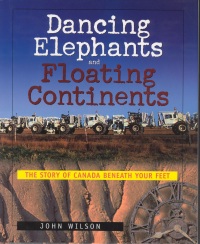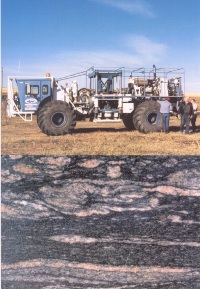| ________________
CM . . .
. Volume X Number 14 . . . . March 12, 2004
excerpt:
Dancing Elephants and Floating Continents is a busy book. In addition to terrifying (through an attempt at humour, I think) British Columbians or readers with relatives in B.C., John Wilson touches on the Lithoprobe Project, a way of determining how Canada formed over the last four billion years using ground pounders called Dancing Elephants. Other topics include earthquakes, rift valleys, mountains, meteorites and mining, and the Slave Continent.
Throughout the book, Wilson uses an analogy to relate the age of the earth to the length of an ordinary school day. This analogy is supposed to simplify events that happened billions of years ago. However, it ends up complicating the situation in a couple of key ways. First, the diagram used to provide a visual explanation of the analogy is confusing in that there are three timelines and not two - one for geographical happenings, one for the school day, and one with eras (like Phanerozoic) and biological happenings marked alongside. These timelines are not labeled to tell us what it is they represent. Second, each time Wilson tells the readers that something happened 1.3 billion years ago (for example), he makes a reference to its school-day equivalent; in this case "1:30 in the afternoon." The problem comes when Wilson is describing more recent events such as an earthquake in 1700. When this happens, the "school-day time" is reduced to the last second of the school day. These "recent" events happen frequently enough for the reader to wonder why Wilson bothered with the analogy if so much that we can measure has happened in the last few seconds of the fictional school day. The book's design is very good. It is an attractive size, captions for illustrations and maps are a different colour and font from the main text, sidebars are presented on a coloured background, and the photos are great. Unfortunately, the maps and drawn diagrams that are meant to aid understanding of the written concepts are, for the most part, small and sometimes difficult to comprehend without referring to the main text. Wilson includes a very good list of annotated Internet resources along with an index. The hands on experiments touted in the promotional materials for this book are truly hands on. In the first, Wilson instructs the reader to place his/her hand on a table and push forward without lifting to illustrate the concept of Canada's bulging west coast. Other "experiments" are similarly simplistic - most of this book's intended audience will not be impressed with a piece of plasticine being torn asunder to replicate an earthquake. Though there are faults with this book (no pun intended), it includes specific information on the geological formation of Canada, and, with teacher or parent assistance, this book could be used to explain how the land we call Canada came to be and how it continues to change. Recommended with Reservations. Grace Sheppard is a Children's Librarian with the Ottawa Public Library in Ottawa, ON.
To comment
on this title or this review, send mail to cm@umanitoba.ca.
Copyright © the Manitoba Library Association. Reproduction for personal
use is permitted only if this copyright notice is maintained. Any
other reproduction is prohibited without permission.
NEXT REVIEW |TABLE OF CONTENTS FOR THIS ISSUE - March 12, 2004. AUTHORS | TITLES | MEDIA REVIEWS | PROFILES | BACK ISSUES | SEARCH | CMARCHIVE | HOME |

 Wilson is clearly enthusiastic about the topics covered in this book. He has a background in history and geology that enables him, most of the time, to explain concepts clearly, even if the concepts are as complex as plate tectonics. At times in this book, Wilson's writing is excellent his description of "a million" is great and fun. At other times, as in the excerpt (above) and the cute page headings (Eating Islands; Cracking Up), Wilson strays too far from the topic at hand in order, I think, to make the book more hip and happening. In recent years, the trend has been to use this kind of joke-y, familiar tone to make nonfiction for kids appealing not only for school projects, but also for browsing. In this case, however, Wilson's tone only makes some parts of the text (usually the beginning of a new topic) hard to get through and confusing.
Wilson is clearly enthusiastic about the topics covered in this book. He has a background in history and geology that enables him, most of the time, to explain concepts clearly, even if the concepts are as complex as plate tectonics. At times in this book, Wilson's writing is excellent his description of "a million" is great and fun. At other times, as in the excerpt (above) and the cute page headings (Eating Islands; Cracking Up), Wilson strays too far from the topic at hand in order, I think, to make the book more hip and happening. In recent years, the trend has been to use this kind of joke-y, familiar tone to make nonfiction for kids appealing not only for school projects, but also for browsing. In this case, however, Wilson's tone only makes some parts of the text (usually the beginning of a new topic) hard to get through and confusing.